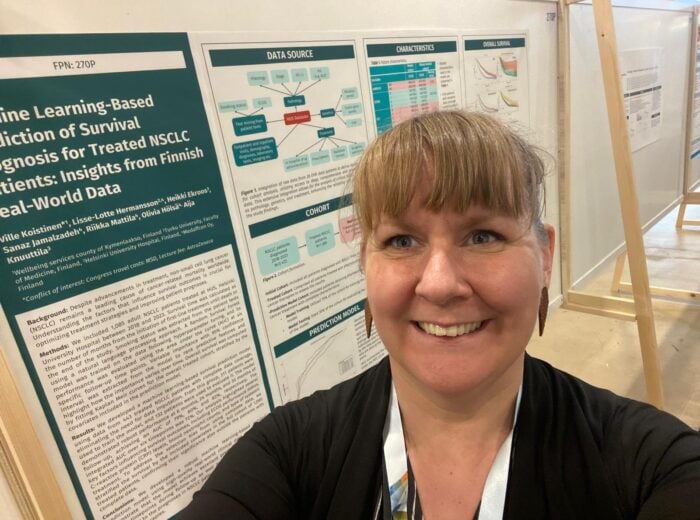Medaffcon Presented Insights from Finnish Real-World Data at European Lung Cancer Congress
Medaffcon's European Lung Cancer Congress (ELCC) poster showcased key findings from a recent study on non-small cell lung cancer (NSCLC).
Techniques such as propensity score matching and inverse probability weighting are essential tools for a broad range of pharmaceutical studies, stresses Samuli Tuominen, senior data scientist at Medaffcon.
Virtual control arms. Also known as external control arms have generated interest worldwide as real-world data-based tools for businesses, research organisations and regulatory authorities to complement the findings of clinical trials.
Real-world data (RWD) can, however, be utilised also in a variety of non-clinical medical and pharmaceutical studies to compare aspects such as treatment outcomes and resource utilisation between different geographies and treatment options, reminds Samuli Tuominen, senior data scientist at Medaffcon.
“The world where matching techniques are applicable is much larger than virtual control arms,” he stresses.
For example, a pharmaceutical company can utilise real world data (RWD) to carry out a study in conjunction with an expansion to or the launch of a product in a new geography.
The key to any such study is patient matching, the process of eliminating confounding interference from factors that could influence the treatment outcome, such as patient age, co-morbidities or treatment history.
Two of the more common matching techniques are propensity score matching and inverse probability weighting, according to Tuominen.
The former makes use of covariates to assess the propensity of a patient receiving a particular treatment and matches patients with similar scores while eliminating those without a suitable match within the defined caliper. The latter does not eliminate any patients but rather gives higher weight to well-matching patient.
“Inverse probability weighting is good especially if the patient population is small,” he says.
The selection of covariates is dictated by disease related clinical insight, but also by the clinical trial or real-world data availability – one may not include row-level patient data; the other may not be consistent across the patient population. Both scenarios can bring about technical challenges, particularly in studies with a small patient population.
“The research question and data availability guide the choice of methods. More advanced matching techniques require higher number of patients, and you simply need to adjust the techniques to the patient data,” sums up Tuominen.
“At Medaffcon, we have the methodological expertise to do that,” he adds, citing as an example a recent study that compared the effectiveness of two immunosuppressants in patients with primary sclerosing cholangitis after liver transplantation. “We also have a lot of experience Finnish registers: we know what data they contain and have a good understanding of the matching possibilities. And then we have a lot of experience in processing and analysing the data.”
This expertise naturally applies to virtual control arms. Tuominen reminds that a virtual control arm can be created for most studies connected to the development or launch of a new pharmaceutical product to examine differences between the trial participants and real-life patients in a region where real-world health care data are available, such as Finland or Sweden.
Such comparisons can produce insights for pharmaceutical companies and regulatory authorities. Comparisons also support decision-making in various stages of pharmaceutical development, from initial market research to final authorisation and beyond.
“At the simplest end of the spectrum, a pharmaceutical company could examine how much the inclusion criteria of a clinical trial, when applied to real-life patients, limit the number of patients who are eligible for the treatment,” tells Tuominen.
“Naturally the inclusion criteria of a clinical trial don’t align perfectly with the treatment’s indication. For example, the age distribution may be such that real-life patients are much older or in much poorer health, possibly with some contraindications. So, in a way it helps to provide an indication about the real market for the upcoming treatment.”
The creation of a virtual control arm starts with the extraction of real-world health data based on diagnoses from regional or national registers. The data can then be enriched with other relevant variables, such as drug purchases, causes of death, or sick –leaves, before the patient cohort is finalised by applying the inclusion and exclusion criteria of the study.
Finally, patients in the control group are matched with their counterparts, be it trial participants or other real-life patients, to enable meaningful comparison of the outcomes.
Medaffcon, founded in 2009, is a Nordic research and consulting company specializing in Real-World Evidence, Medical Affairs, and Market Access. With offices in Stockholm, Sweden, and Espoo, Finland, we provide expert services across the Nordic region. Our services combine strong medical and health economic expertise with modern data science.
The company employs some 30 experts. Since 2017, Medaffcon has been a subsidiary of Tamro Oyj and is part of the PHOENIX group, which is a leading provider of healthcare services in Europe.

Medaffcon's European Lung Cancer Congress (ELCC) poster showcased key findings from a recent study on non-small cell lung cancer (NSCLC).

The algorithm was originally developed to extract smoking status from patient texts with purpose to analyze the effects of smoking on postoperative complications. Today, it is also being utilized in lung cancer research.

5th Nordic RWE and AI conference is organized by University of Helsinki and Åbo Akademi University. Register to the event here!

Sr. Data Scientist
MSc (Statistics)
Samuli joined Medaffcon in November 2018. He acquired a master’s degree in Statistics at the University of Helsinki, specializing in Bioinformatics in September 2018. Before joining Medaffcon, Samuli had two years’ worth of experience in research as a research assistant at the University of Helsinki, where he contributed to unraveling the genetic and epigenetic background of psychological characteristics (Depsy-group).
Samuli is especially interested in producing influential research data based on information on real-world patients. He is also interested in applying varying statistical and machine learning methods. Samuli has a broad theoretical and methodological understanding, as well as experience in working with big data. He is a problem solver and has an analytical take on work.
“I see that the health sector is being transformed by digitalization. I am excited to further develop the new opportunities made possible by the automated collection of patient data”.

Sr. Scientific Advisor
RWE Lead
PhD
+358 50 345 2393
mariann.lassenius@medaffcon.com
Mariann joined Medaffcon’s team in 2016 after finishing her PhD. The transition to real world evidence (RWE) research was a natural continuum to her previous research career. Through RWE studies, she has had the privilege to gain a broad insight into working with different stakeholders within the healthcare field. The vast proportion of her days goes towards interacting with clients, planning and performing RWE studies, and supporting Medaffcon’s RWE team. Subjects that keep her work interesting are the vast variability of customers and projects, problem-solving, and interacting with people.
“The number of RWE studies has increased since stakeholders within the healthcare industry have an increasing demand for knowledge-based decision making tools that need to be fulfilled. The future, therefore, has an ever-increasing emphasis on RWE”.